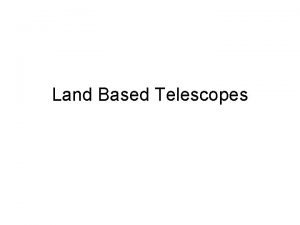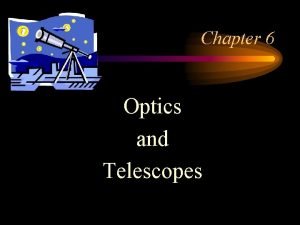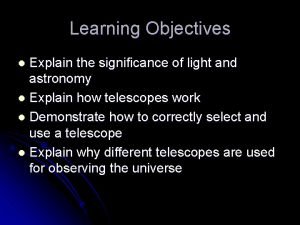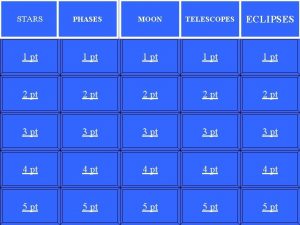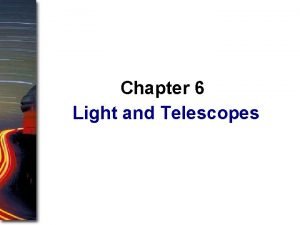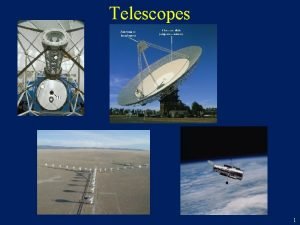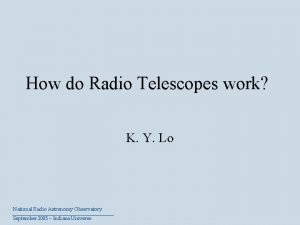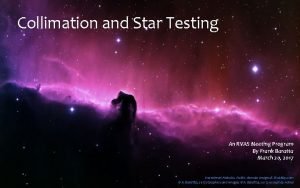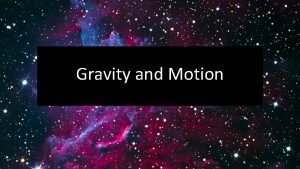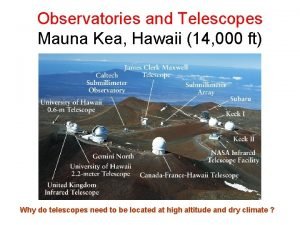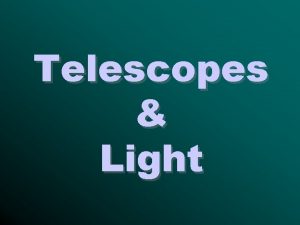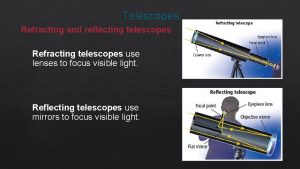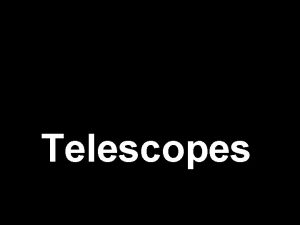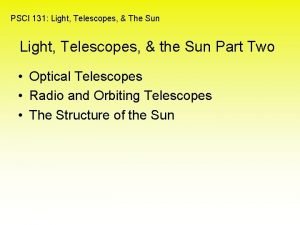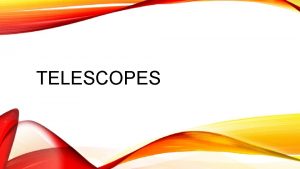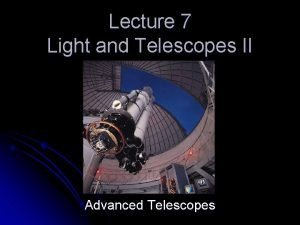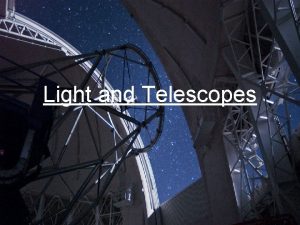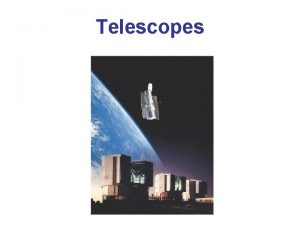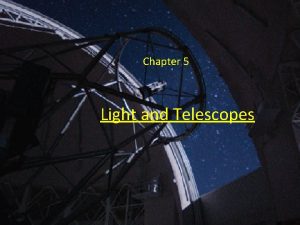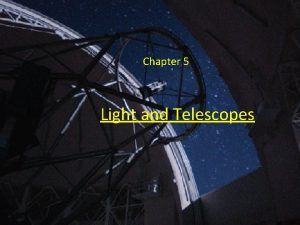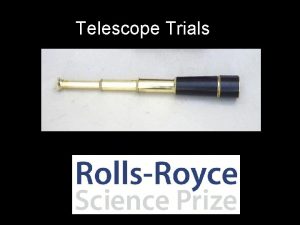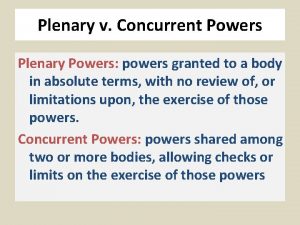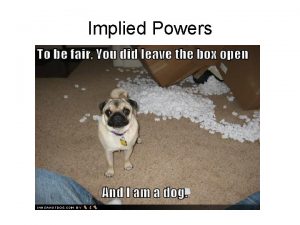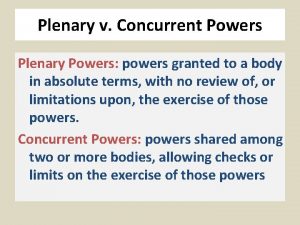Telescopes Light The Powers of a Telescope Light











































- Slides: 43

Telescopes & Light

The Powers of a Telescope Light Gathering Power: Astronomers prefer *large* telescopes. A large telescope can intercept and focus more starlight than does a small telescope. A larger telescope will produce brighter images and will be able to detect fainter objects. Resolving Power: A large telescope also increases the sharpness of the image and the extent to which fine details can be distinguished. Magnification: The magnifying power is the ability of the telescope to make the image appear large in the field of view.

Size Does Matter Light-Gathering Power: Depends on the surface area (A) of the primary lens and is proportional to the telescopes diameter. D

The Powers of a Telescope Resolving Power: Wave nature of light: The telescope aperture produces fringe rings that set a limit to the resolution of the telescope.

The Powers of a Telescope Magnifying Power The ability of the telescope to make the object’s optical image appear bigger while being observed A larger magnification does not improve the resolving power of the telescope!

Types of Telescopes Refracting Telescopes: Use lenses as the optics to focus and bend light. Galileo used a refracting telescope. The human-eye is partly a refracting telescope.

Refracting Telescope Objective Lens Focal Length Objective Eyepiece Lens Focal Length of Eyepiece Refracting Telescope: Lens focuses light onto the focal plane Focal length

Disadvantages Refracting telescopes suffer from Chromatic Aberration As light passes through a lens, just as a prism will disperse light, the lens will focus bluer wavelengths differently than the redder wavelengths. Blue Focus Red Focus

Disadvantages • Cannot be made very large for a multitude of reasons. • Get to be very expensive to maintain. • Lenses can grow “cloudy” over time. • Lenses can distort over time.

140 -ft Hevelius telescope 1673

Types of Telescopes Reflecting Telescopes: Use mirrors as the optics to focus and bounce light. The rear view mirror on your car is a simple reflecting telescope. Reflecting Telescope: Concave Mirror focuses light onto the focal plane Focal length Most modern telescopes are reflecting telescopes.

Reflecting Telescope

Advantages Reflecting telescopes do not suffer from Chromatic Aberration. All wavelengths will reflect off the mirror in the same way. Reflecting telescopes can be made very large because the mirrored surfaces have plenty of support. Thus, reflecting telescopes can greatly increase in light gathering and resolving power. Reflecting telescopes are often cheaper ($$$) to make than similarly sized refracting telescopes.

Newton’s Telescope: The first reflecting telescope

Hey! Where are you going? The Doppler Effect The wavelength of light is effected by the relative motion between the source and the observer. Christian Doppler (1803 -1853), a professor of mathematics in Prague, pointed out in 1842 that the observed wavelength of light is affected by motion. The frequency increases when the source and observer are approaching each other, and decreases when they are moving away from each other.

The Doppler Effect Observer Stationary Towards Blueshift Away Redshift

Observer

Strength of the Light with this Wavelength How does this help? Star moving Stationary Star towards from us Wavelength Star moving away from us

Telescopes

Where to put a Telescope? Far away from civilization – to avoid light pollution

Where to put a Telescope? On high mountain-tops – to avoid atmospheric turbulence and other weather effects

On high mountain-tops – to avoid atmospheric turbulence and other weather effects

“Seeing” Weather conditions and turbulence in the atmosphere set further limits to the quality of astronomical images. Bad seeing Good seeing







Hubble Space Telescope

X-Ray Astronomy X-rays are completely absorbed in the atmosphere. X-ray astronomy has to be done from satellites. NASA’s Chandra X-ray Observatory

Gamma-Ray Astronomy Gamma-rays: most energetic electromagnetic radiation; traces the most violent processes in the Universe The Compton Gamma-Ray Observatory

Radio Astronomy







Radio Interferometry

Radio Interferometry The Very Large Array (VLA): 27 dishes are combined to simulate a large dish of 36 km in diameter. Even larger arrays consist of dishes spread out over the entire U. S. (VLBA = Very Long Baseline Array) or even the whole Earth (VLBI = Very Long Baseline Interferometry)!


 Presidential powers informal or implied powers
Presidential powers informal or implied powers What's the difference between enumerated and implied powers
What's the difference between enumerated and implied powers Was the united states on the axis powers or allied powers?
Was the united states on the axis powers or allied powers? Implied powers vs expressed powers
Implied powers vs expressed powers Causes of wwi (mania)
Causes of wwi (mania) How do delegated, reserved, and concurrent powers differ?
How do delegated, reserved, and concurrent powers differ? Implied powers vs expressed powers
Implied powers vs expressed powers Light bucket telescope
Light bucket telescope All modern large optical telescopes are refractors.
All modern large optical telescopes are refractors. Refracting telescopes exhibit great focus and color.
Refracting telescopes exhibit great focus and color. Computer controlled telescopes
Computer controlled telescopes New moon telescopes
New moon telescopes Guidepost of light
Guidepost of light Structure of radio telescope
Structure of radio telescope How do radio telescopes work
How do radio telescopes work Collimation star test
Collimation star test A building that contains one or more telescopes
A building that contains one or more telescopes Modern telescopes make it possible for astronomers
Modern telescopes make it possible for astronomers Timeline of telescope
Timeline of telescope Chromatic aberration affects reflector telescopes.
Chromatic aberration affects reflector telescopes. Chapter 22
Chapter 22 Light light light chapter 23
Light light light chapter 23 Into the light chapter 22
Into the light chapter 22 Cái miệng nó xinh thế
Cái miệng nó xinh thế đặc điểm cơ thể của người tối cổ
đặc điểm cơ thể của người tối cổ Cách giải mật thư tọa độ
Cách giải mật thư tọa độ Bổ thể
Bổ thể Tư thế ngồi viết
Tư thế ngồi viết Thẻ vin
Thẻ vin Thơ thất ngôn tứ tuyệt đường luật
Thơ thất ngôn tứ tuyệt đường luật Chúa yêu trần thế
Chúa yêu trần thế Các châu lục và đại dương trên thế giới
Các châu lục và đại dương trên thế giới Từ ngữ thể hiện lòng nhân hậu
Từ ngữ thể hiện lòng nhân hậu Diễn thế sinh thái là
Diễn thế sinh thái là Vẽ hình chiếu vuông góc của vật thể sau
Vẽ hình chiếu vuông góc của vật thể sau Thứ tự các dấu thăng giáng ở hóa biểu
Thứ tự các dấu thăng giáng ở hóa biểu Phép trừ bù
Phép trừ bù Tỉ lệ cơ thể trẻ em
Tỉ lệ cơ thể trẻ em Lời thề hippocrates
Lời thề hippocrates Hổ đẻ mỗi lứa mấy con
Hổ đẻ mỗi lứa mấy con đại từ thay thế
đại từ thay thế Quá trình desamine hóa có thể tạo ra
Quá trình desamine hóa có thể tạo ra Cong thức tính động năng
Cong thức tính động năng Thế nào là mạng điện lắp đặt kiểu nổi
Thế nào là mạng điện lắp đặt kiểu nổi







